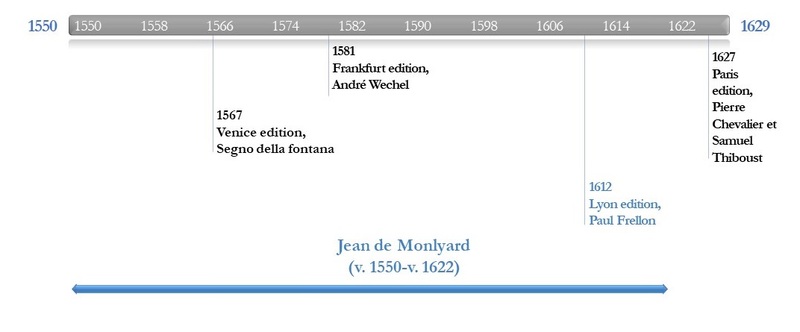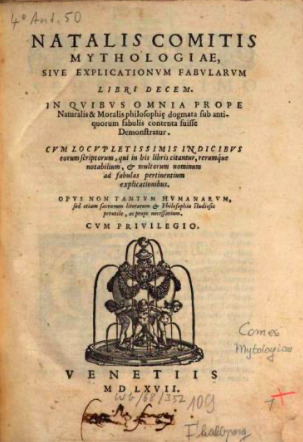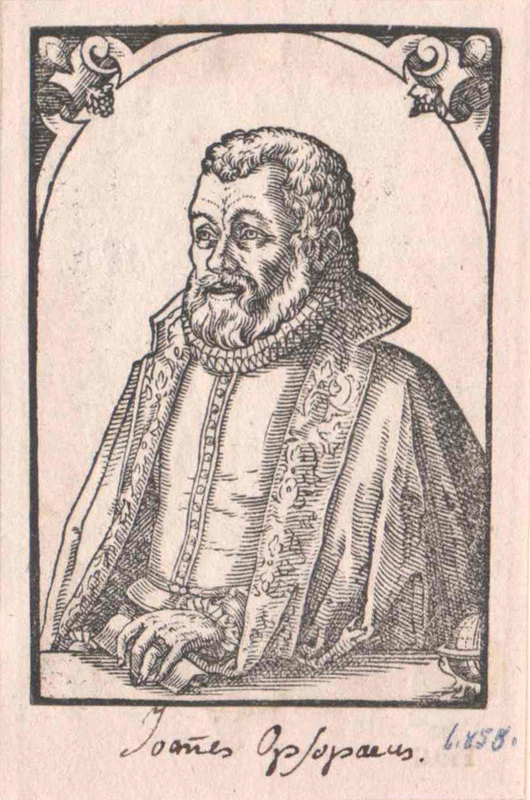Jean de Monlyard (15..-16..). A Bio-bibliographical Essay


Frontispiece of the 1612 edition
© Münchener DigitalisierungsZentrum (MDZ)
Jean de Montlyard, first French adapter of Mythologies by Conti, the which translation made a considerable fortune, has been the object of very little critical analysis. Recently, even the ambitious Histoire des traductions en langue française[1] shed no light on him whom Jean-Paul Barbier Mueller described – perhaps a bit hastily – as a ‘modest litterateur’.[2]
The bio-bibliographic records mostly draw upon the same older source material.[3] La nouvelle Bibliographie générale, published in the second half of the 19th century by Firmin Didot, provides an overview of the piecemeal information which circulate about Montlyard to this day: “French litterateur, born around 1530, he was Lord of Melleray in Beauce. Refugeed in Geneva, he was accepted as a burgher in that town and served the canton as minister from 1554. His date of death is unknown.”[4] These few lines raise as many questions as they answer regarding at least two aspects, which the record writers also sometimes point out. The first is the very advanced age Montlyard would have been at when his translation of Aethiopica by Heliodorus was published in 1622, even if we were to assume a posthumous publication. The second point relates to his translation of The Golden Ass by Apuleius (1602), faithful to the original down to the most licentious and obscene details, which can be surprising coming from a Calvinist pastor in exercise. Given these two difficulties, commentators suggest the possibility that these works were written not by him, but by his son.
In fact, research done by Sara Petrella in recent years on the illustrated edition of the Mythologie (1612) dispelled that misunderstanding.[5] There are indeed two Jean de Montlyards: the father, a pastor, born around 1530, and his son, a writer and translator, born in 1550. Jean de Montlyard the elder, sometimes known as Jean Melrey, exercised his functions as a pastor of the Reformed Religion in the Geneva Church, in the parishes of Draillans and Céligny between 1554 and 1563 when he died.[6] Sara Petrella also points out that he obtained the status of burgher in Geneva on August 31, 1559. As for the younger Jean de Montlyard, he was likely born in Geneva, where he would have done his studies, before his employment as proofreader at the famous printer and book seller Henri Estienne.[7] He later became advisor and secretary to the young Prince of Condé, Henri II of Bourbon. At least, that is how he was introduced by one of his friends, the Portuguese Dominican José Teixera, in a work from 1598.[8] He left Geneva at an unknown date. The dedication to Charles de Gonzague at the beginning of his translation of Miroir de la procédure (1595) is signed off in Paris.
Despite his position as secretary and adviser to the Prince of Condé—about which more precisions should be worked out as to its length and breadth—Jean de Montlyard seems to have been in constant search of patrons. Almost all his works were headed with dedications which presumably could help him either financially or institutionally. Montlyard bitterly recalled that sought-after support in a dedication to Jean Rouen, preacher and chaplain to the king, appointed as provost to the Collège des Thrésoriers which he put at the beginning of L’Asne d’or.
“And if anyone should be surprised that I prefer you to many Princes, to many of the powerful and of the illustrious by whom authors have custom to enrich their writ: please tell them with me; that I much prefer your intimacy to fleeting hope, your friendship to empty promises. I know as well by experience, that the Great are just as happy to not take notice of those to whom they have obligations, owe pleasures, or services, or gifts, believing that when they are approached, it is only to be admonished for any illiberality. I know not how to do such a thing. Moreover, my disposition is not one to wait at anyone’s doorstep like some lackey.”[9]
This declaration of principle should be kept in perspective with the fact that this edition of L’Asne d’or was issued a second time, indistinguishable from the first except for the dedication to Jacques Nompar de Caumont.[10] Despite his refusal to ‘wait at the doorstep’ of the powerful ‘like some lackey’, Montlyard seemingly needed to accumulate protectors and requests.
Montlyard’s activity as man of letters spanned from 1580 to 1622. During those forty odd years, he probably published around ten translations, as well as two works of his own. Doubt remains as to the authorship of one part of his works, which he did not always sign, or only initialed “I.D.M.”, relatively commonplace, thus possibly referring to other authors.
Montlyard’s translations are divided into two distinct sets, which also somewhat correspond to two different periods. If we set aside his first translation of a medical and astronomy treatise from 1580,[11] we can see that from 1588 to 1599 Montlyard essentially translated political or religious works. Then, at the turn of the century, his interest was directed towards fables, and fiction relating to antiquity more broadly. There is, admittedly, a certain perplexity regarding the political or religious translated texts. First, there may have been a treatise by Matteo Zampini, a fervent Catholic League member close to Catherine de Medici, translated in 1588 entitled Estats de France et de leur puissance.[12] The conditional mood is proper here as the work was signed only by the initials “I.D.M.”. The record at the Bibliothèque Nationale de France (BnF) wavers between Montlyard and a certain J.D. Matthieu, about whom little is known.[13] Jean Balsamo attributes it indisputably to Montlyard,[14] though one can question the ideological coherence of a Genevan, close to Protestant circles, in choosing such a text. Nonetheless, in 1599 it was indeed Montlyard who signed a translation of Sermons de Caresme by François Panigarola, a translation that can only be the work of an author with League sympathies. Strangely, during those same years, it is to him that Jean de Serres, historiographer and Calvinist pastor, entrusted the task of finishing his Inventaire de l’Histoire de France after his death in 1598. There are no clues to allow us to precisely date Montlyard’s possible conversion to Catholicism who, it is assumed, was raised in the Protestant faith, but his translation choices sketch the profile of a religiously fluctuating political itinerant. Finally, in this first period, Montlyard translated three works by José Teixeira, between 1595 and 1597. This Portuguese Dominican living in Paris presented himself Montlyard’s friend.[15] One of these works, Explication de la généaologie de treshault et trespuissant Henri prince de Condé (1596) indicates that the origins of this friendship can likely be found among acquaintances he had in common with the Prince of Condé. The two other texts, Le miroir de la procedure de Philippe Roy de Castille en l’ursurpation du Royaume de Portugal (1594) and the Traicté paraenetique (1596), are pamphlets written against Philippe II whom José Teixeira considered as a usurper after the annexation of Portugal in 1580. The Traicté paraenetique which was moreover translated into Flemish and English in 1598, is more broadly characterized by attacks against Spain and the Spanish.
The publication of Mythologie in 1600 was a turning point in the translator's productions as he abandoned political and religious current events. This was followed by The Golden Ass (1602) by Apuleius, Hieroglyphics by Pierio Valeriano (1615)[16] and The Loves of Theagenes and Charicleia (1622), as well as a translation of Heliodorus' Greek romance, Aethiopica.[17] The Mythologie was a great success with booksellers and it was received with much fanfare, renewing the translator's vigor. In his version of Conti's text, Montlyard does not hesitate to take liberties with the source material, while still keeping faithful to the original text in his own way.[18] In his preface to The Golden Ass, he presents himself as the great restorer of Apuleius' romance from the corruption inflicted on it in a prior translation by Jean Louveau. He hammers his predecessor, which in turn gives him leave to praise his own rendering in French, indeed globally faithful to the letter of the Latin romance, but also amplifying certain passages.[19] In his commentaries appended to the translation, we see him in a new light, that of lexicologist, making meticulous remarks on this or that word choice to better render the original Latin into French,[20] careful to find the mot juste, as can be seen here with the word renardesque [fox-like]:
“We have long incorporated words of the same formation, soldatesque [soldier-like], larronesque [pilferer-like], etc; moreover, I know no term more pregnant in meaning to express Apuleius' Vulpinaris amasio. Renarder [to fox] means to pervert the truth by fraud and untruth, in short, to play a trick like a fox. The animal's guile and deceit are inherent in the word. In the same way, a fox-like lover is seen as an unfaithful lover, an impostor. There is no beast more industrious and cunning. Aesop's fables bear witness to it, and we learn it from experience as well".[21]
Jean de Monlyard would also sign—or not sign—two works of his own authorship, namely, as stated above, his continuation of L'inventaire de l'Histoire de France commissioned by Jean de Serres. At least, that is what Montlyard asserted in his dedication letter addressed to the Baron de Vignolles La Hire which accompanied copies of Mythologie from the 1604 edition on: A letter written by the late Monsieur Serres just before his death—his memory will always be a happy one for me and for the friends we had in common before his parting—was the impetus for me to continue what remained unfinished subsequent to the reign of Charles VII.”[22] Two volumes had in fact already been published by 1597, dealing with the history of France up to 1422. The editions put out in 1600 and 1606 were expanded to the reign of Henri IV by Montlyard.
The other work attributed to Montlyard isL'anti-Jésuite ou discours du roi contre les Jésuites sur la mort de Henri IV, published in Saumur in 1611. In it, he accuses the Jesuits of being responsible for the assassination of the king and calls for their banishment.[23]
Montlyard's works were principally published in Paris and Lyon. His connection to Paul Frellon who not only edited Mythologie but also Sermons de Caresme and Hieroglyphics, is still a subject to be explored, along with the French-Genevan network among the Lyon booksellers.
[1] Véronique Duché (dir.), Histoire des traductions en langue française. XVe et XVIe siècles. 1470-1610, Lagrasse, Verdier, 2015 et Yves Chevrel, Annie Cointre et Yen-Maï Tran-Gervat (dir.), Histoire des traductions en langue française. XVIIe et XVIIIe siècles. 1610-1815, Lagrasse, Verdier, 2014.
[2] Jean-Paul Barbier Mueller, Dictionnaire des poètes français de la seconde moitié du XVIe siècle (1549-1615). Tome II : C-D, Genève, Droz, 2015, p. 251.
[3] See Prosper Marchand, Dictionaire historique, La Haye, Pierre de Hondt, 1758-1759, t. II, p. 66-75 ; Eugène and Émile Haag, La France protestante, Paris, J. Cherbuliez, 1857, t. VII, pp. 490-491.
[4] Nouvelle biographie générale, Paris, Firmin Didot frères, 1858, t. XXVI, p. 328. The BnF's authority record includes these elements.
[5] Sara Petrella, Dieux en métamorphose : regards croisés sur la Mythologie, c'est-à-dire explication des fables (Lyon, 1612), Phd dissertation, Geneva, 2017 [not accessed] ; « Enquête autour d'un livre hybride : La première édition illustrée de la Mythologie de Natale Conti », Péristyle. Référentiel thématique (Histoire de l'art, patrimoine bâti et art décoratif), may 2013 (online journal) ; « La traduction française de la Mythologie de Natale Conti par Jean de Montlyard : représentation textuelle et iconographie de Bacchus », ASDIWAL, Revue genevoise d'anthropologie et d'histoire des religions, n°6, 2011, pp. 173-178.
[6] Voir les Registres de la Compagnie des pasteurs de Genève au temps de Calvin. T. II, 1553-1564 : Accusation et procès de Michel Servet, Geneva, Droz, 1962, p. 56 et 76.
[7] Sara Petrella, « La traduction française de la Mythologie de Natale Conti par Jean de Montlyard : représentation textuelle et iconographie de Bacchus », art. cit., p. 175.
[8] José Teixeira, Rerum ab Henrici Condaei, Paris, L. Delaz, 1598, p. 208.
[9] L’Asne d’or, Paris, Abel L’Angelier, 1602, ã2v.
[10] See Jean Balsamo and Michel Simonin, Abel L'Angelier et Françoise de Louvain : 1574-1620. Suivi du Catalogue des ouvrages publiés par Abel L'Angelier, 1574-1610 et la veuve L'Angelier, 1610-1620, Geneva, Droz, 2002, pp. 317-318.
[11] Antoine Mizauld, L’Harmonie des corps celestes et humains, Lyon, Benoist Rigaud, 1580. First latin edition: 1555.
[12] Paris, Rolin Thierry, 1588. The Italian originale dates from 1578. See Jean Balsamo, L'amorevolezza verso le cose italiche : le livre italien à Paris au XVIe siècle, Geneva, Droz, 2015, pp. 155-156 : « Composé par Matteo Zampini à l’occasion de la réunion des Etats généraux à Blois (ouverts le 6 décembre 1576), ce traité, fondé sur une vaste érudition historique, se propose de montrer la continuité de la puissance absolue des rois et la puissance relative des Etats, qui ne participent à l’administration du royaume que dans des cas particuliers ».
[13] See M. Barbier, Dictionnaire des ouvrages anonymes ou pseudonymes, Paris, Barrois l’aîné, 1822, p. 455.
[14] Jean Balsamo, op. cit., p. 156.
[15] José Teixeira, Rerum ab Henrici Condaei, Paris, L. Delaz, 1598, p. 208. José Teixeira was a close associate of the Portuguese infant Dom Antonio, a candidate for the Portuguese throne in 1580 and a refugee in France from 1581. Father Teixeira defended his rights against Philip II of Spain. He was also chaplain to Marie de Médicis and adviser to Henri IV. He died in Paris in 1604.
[16] This appears to be a revision of the translation by Gabriel Chappuys, Commentaires hiéroglyphiques, Lyon, B. Honorat, 1576.
[17] The attribution of this last translation to Montlyard has been disputed. See A. Cioranescu, Bibliographie de la littérature française du XVIIe siècle, Paris, CNRS, 1966, t. II, p. 1489.
[18] See Céline Bonhert, « Quelques réflexions sur l’usage de la métaphore dans les Mythologiæ de Natale Conti et leurs traductions françaises », dans B. Petey-Girard and C. Trotrot (dir.), Métaphore, savoirs et arts au début des temps modernes, Paris, Garnier, 2015, pp. 157-179.
[19] See Carole Primot, « Une rature depuis la première page jusqu'à la dernière » : la leçon de traduction de Jean de Montlyard », Présences du traducteur, Véronique Duché and Françoise Wuilmart (dir.), Paris, Classiques Garnier, 2021, pp. 247-257.
[20] See Takeshi Matsumura « Une source du dictionnaire de Cotgrave : L’Asne d’or de Jean de Montlyard », FRACAS, Groupe de recherche sur la langue et la littérature françaises du centre et d'ailleurs (Tokyo), 2018.
[21] L’Asne d’or, éd. cit., livre III, p. 108.
[22] Mythologie, Lyon, Paul Frellon, 1612, A6r.
[23] Voir Sylvio De Franceschi, « Le principe de souveraineté à l’épreuve. Raison du prince et hostilité catholique à la Compagnie de Jésus en France de l’assassinat d’Henri IV aux États Généraux de 1614-1615 », in Europa Moderna. Revue d'histoire et d'iconologie, n°2, 2011, pp. 51-52.
Carole Primot
translated by Erin Curran
Comment citer cette page
Équipe Mythologia, "Jean de Monlyard (15..-16..). A Bio-bibliographical Essay"Site "Natale Conti, Mythologia, 1567-1627 : un laboratoire éditorial"
Consulté le 30/11/2025 sur la plateforme EMAN
https://eman-archives.org/Mythologia/jean-de-monlyard





